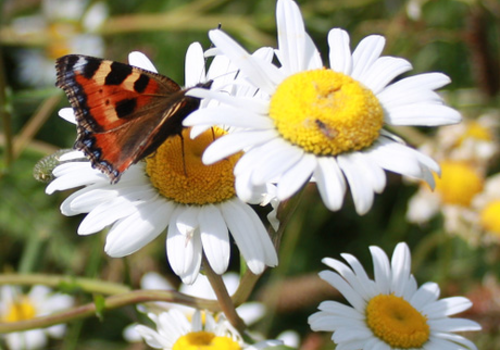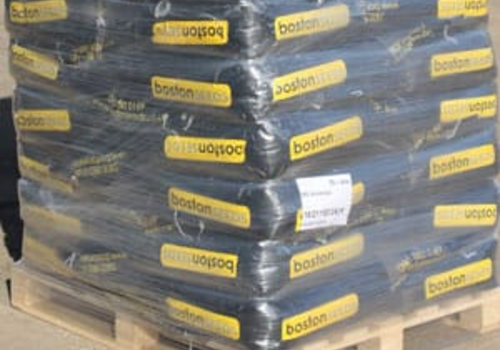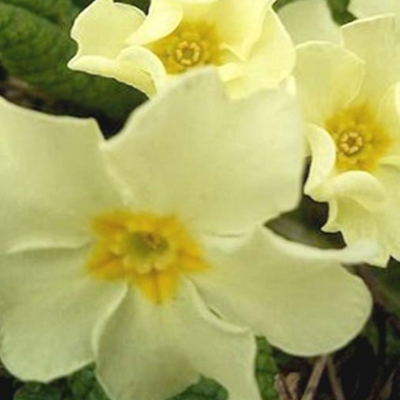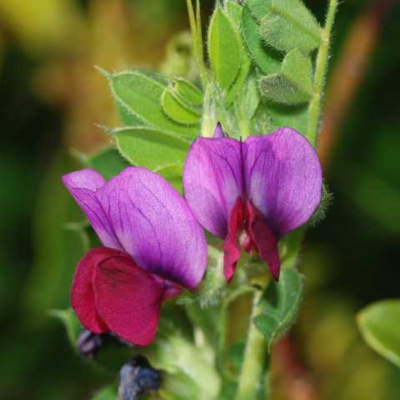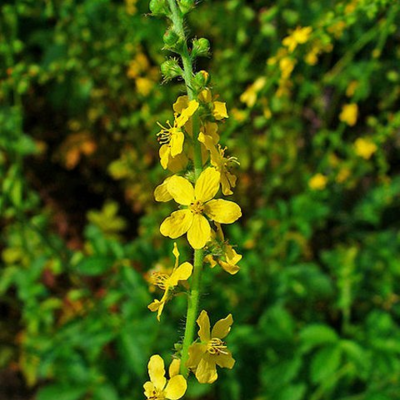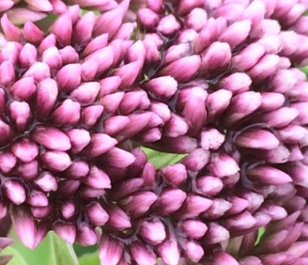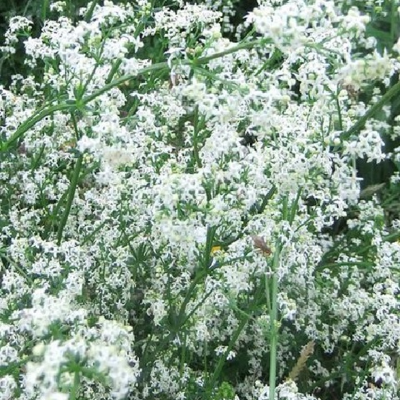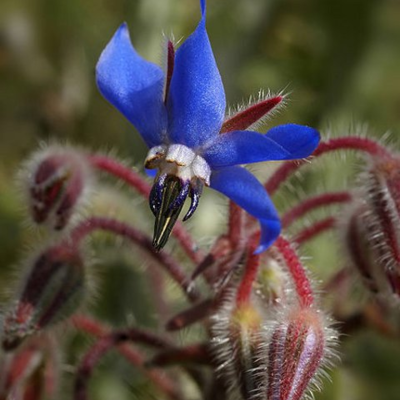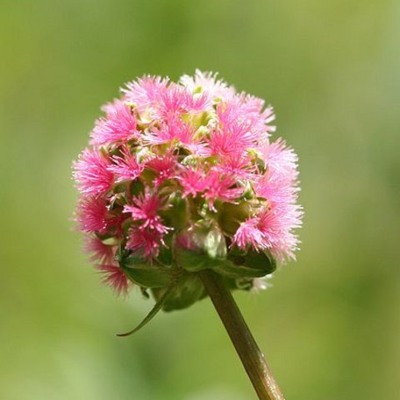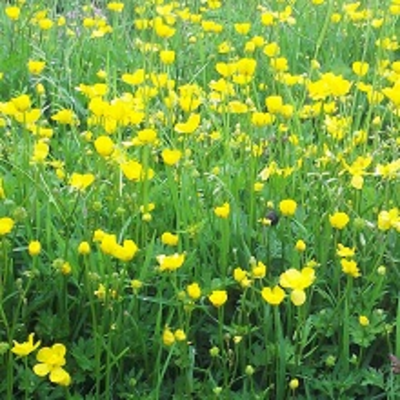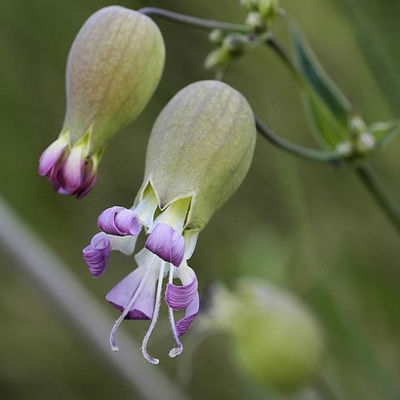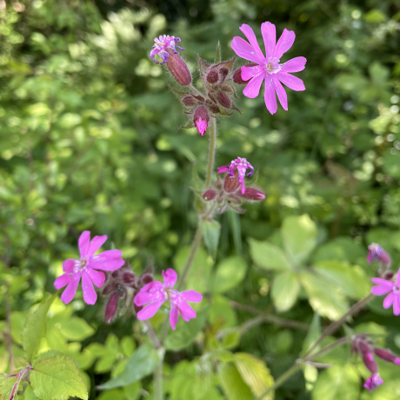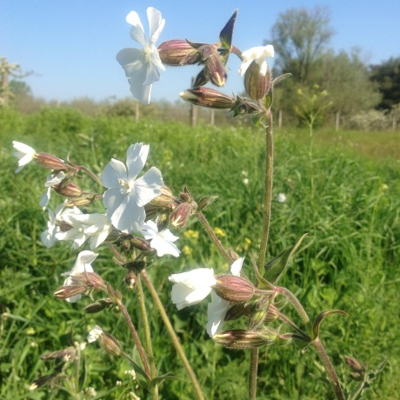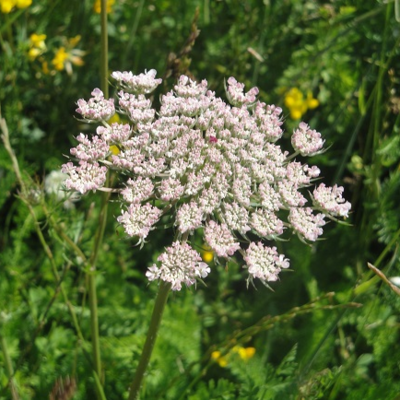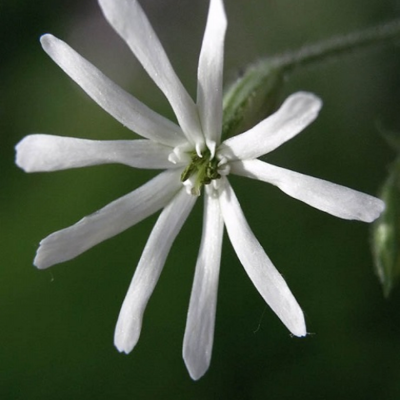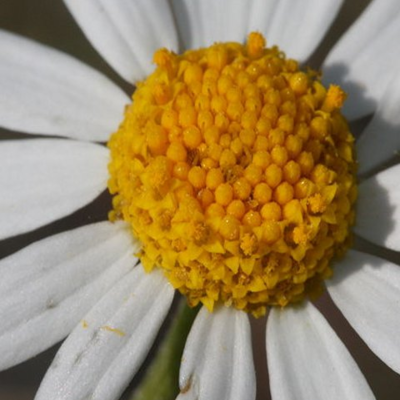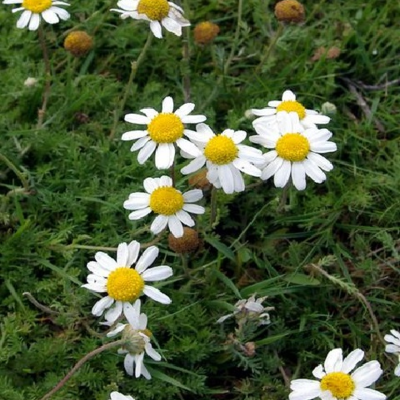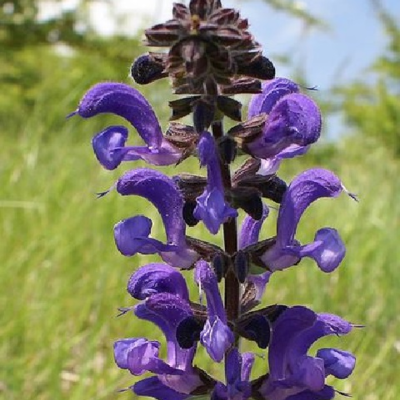Wildflower Plants A to Z
Choose from our entire range of over 100 wildflower plug plants, expertly grown in our very own nursery from high quality, UK native wildflower seed. Our wildflower plugs are ready to be planted straight out into your garden or meadow as soon as they arrive, all year round. Buying individual wildflower plants is one of the best ways to establish your chosen wildflower species, planted individually or as part of a more diverse meadow created from our range of wildflower seeds.
Don't hesitate to get in touch to speak to one of our experts or request a catalogue to view our full range. Ordering regularly or looking for large volumes? Click here to apply for a trade account today - we review all applications within one working day.

Plants for Pollinators highlights plants selected by the RHS as scientifically proven to tackle the declines in bees, butterflies and other pollinators.
The Wild Primrose’s pale yellow, five-petalled flowers are a cottage classic! Its light colouration is a delight under trees and bushes- just imagine a shady spot illuminated by sweet-scented, hardy clusters of buttery beauty!
- Type: Perennial
- Height: 20-30cm.
- Flowers: February-May
- Soil Requirement: Moist but well-drained
- Light Requirement: Full sun or partial shade
- Natural Habitat: Woodland, grassland
- Also known as: Culver Keys, Suncups

Plants for Pollinators highlights plants selected by the RHS as scientifically proven to tackle the declines in bees, butterflies and other pollinators.
These climbing woodland legumes have an earnest and delicate charm not seen in others of its kind: its small, two-tone, pea-like petals in rich pink and purple look a bit like butterflies, which may be why they're so attractive to pollinators.
- Type: Annual
- Height: 45–75cm.
- Flowers: June-September
- Soil Requirement: Well-drained
- Light Requirement: Full sun
- Natural Habitat: Grasslands, verges, coastal areas
- Also known as: Fetch, Lintels

Plants for Pollinators highlights plants selected by the RHS as scientifically proven to tackle the declines in bees, butterflies and other pollinators.
Common Agrimony is an attractive, medium height meadow plant, consising of tall spires of star-shaped, sunny yellow flowers. An wildlife-friendly flower, it's attractive to pollinators as well as wild birds.
- Type: Perennial
- Height: 40-80cm
- Flowers: June to September
- Soil requirement: Neutral, well-drained
- Light requirement: Full sun or partial shade
- Natural habitat: Southern UK, grassland, meadows, roadsides
- Also known as: Church Steeples, Sticklewort, Aaron's Rod, Clot-Bur, Fairy's Wand, Money-In-Both-Pockets, Salt-And-Pepper, Sweethearts
A tall-growing upright marsh flower, which grows plentiful parachutes of pink-and-white florets on red stems, and they’re also known for their pleasant perfume when cut. This whimsically-coloured wildflower is also perfect for pollinators!
- Type: Perennial
- Height: 60–120cm.
- Flowers: July-September
- Soil Requirement: Damp
- Light Requirement: Full sun or partial shade
- Natural Habitat: Marshlands, river banks
- Also known as: Hemlock Parsley, Holy Rope, Raspberries-And-Cream, Water Agrimony
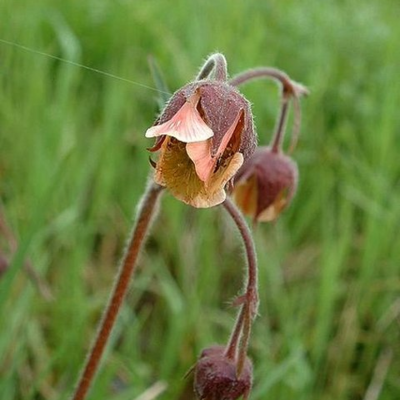

Plants for Pollinators highlights plants selected by the RHS as scientifically proven to tackle the declines in bees, butterflies and other pollinators.
Though it prefers cool spots in the garden, the Water Avens are warmly-hued wildflowers, with gently nodding, burgundy stems and sepals- gorgeous enough on their own, but blooming into cups of peach-coloured petals that make the perfect addition to a pond-side palette!
- Type: Perennial
- Height: 30–45cm.
- Flowers: April-June
- Soil Requirement: Damp
- Light Requirement: Full sun to shade
- Natural Habitat: Coasts, woodlands, damp meadows
- Also known as: Chocolate Root, Indian Chocolate, Purple Avens
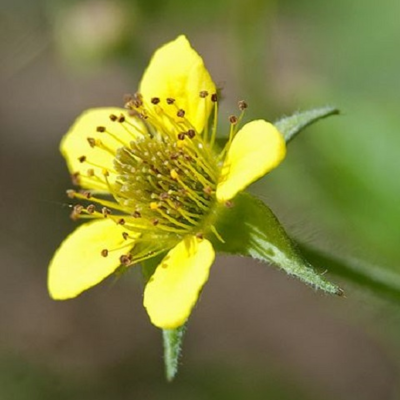

Plants for Pollinators highlights plants selected by the RHS as scientifically proven to tackle the declines in bees, butterflies and other pollinators.
Once named a 'blessed herb' for its uses in herbalism, this hardy, leafy plant can still bless your garden with small, star-shaped, buttery yellow blooms which add some extra brightness to a shady spot- as well as sweetness, as they're nectar-rich and ideal for pollinators.
- Type: Perennial
- Height: 30-60cm.
- Flowers: May-August
- Soil Requirement: Well-drained
- Light Requirement: Partial Shade
- Natural Habitat: Woods, hedgerows, roadsides
- Also known as: Herb Bennett, Colewort, St. Benedict's Herb, Blessed Herb
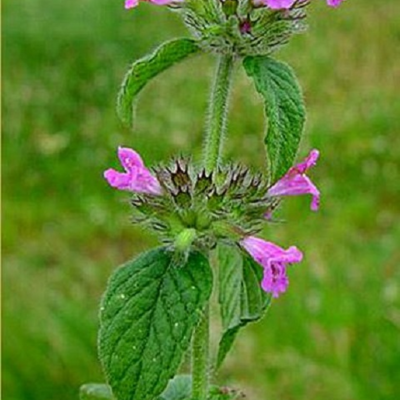

Plants for Pollinators highlights plants selected by the RHS as scientifically proven to tackle the declines in bees, butterflies and other pollinators.
Best known for their distinctly-shaped and aromatic leaves, the basil plant has a lot to provide inside the garden and out, as it produces whorls of royal purple and pink petals which are perfect for pollinators.
- Type: Perennial
- Height: 30-60cm.
- Flowers: July-September
- Soil Requirement: Well-drained, calcareous
- Light Requirement: Full Sunlight
- Natural Habitat: Dry meadows, forests, hedgerows
- Also known as: Cushion Calamint

Plants for Pollinators highlights plants selected by the RHS as scientifically proven to tackle the declines in bees, butterflies and other pollinators.
A rambling, hairless hedge plant, which produces clusters of tiny, star-shaped flowers in fresh white. Noted for its sweet scent, this vigorous wildflower can grow quite tall when clambering alongside hedges and shrubs.
- Type: Perennial
- Height: 30–75cm.
- Flowers: July-August
- Soil Requirement: Well-drained, calcarerous
- Light Requirement: Partial shade
- Natural Habitat: Woodlands, grasslands, hedgebanks
- Also known as: False Baby’s Breath, Whip Tongue, Wild Madder
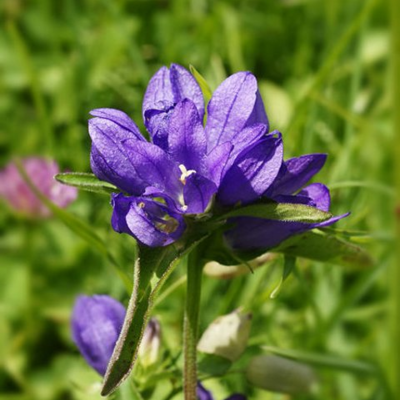

Plants for Pollinators highlights plants selected by the RHS as scientifically proven to tackle the declines in bees, butterflies and other pollinators.
As its name suggests, the Clustered Bellflower sprouts dense bursts of vivid violet-blue flowers. Each flower is its own brilliant bouquet, on top of being hardy and attractive to bees and butterflies!
- Type: Perennial
- Height: 30–75cm.
- Flowers: June-September
- Soil Requirement: Well-drained, chalky
- Light Requirement: Partial shade
- Natural Habitat: Grasslands, coastal cliffs
- Also known as: Dane’s Blood
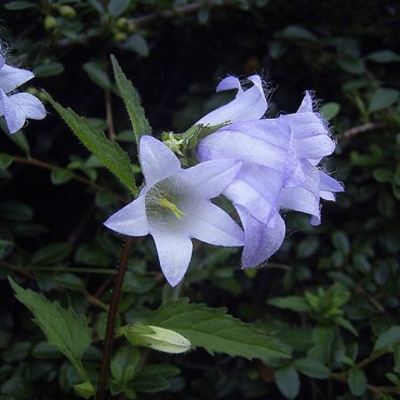

Plants for Pollinators highlights plants selected by the RHS as scientifically proven to tackle the declines in bees, butterflies and other pollinators.
Though named for its nettle-like leaves, one mustn’t overlook the beauty of this bloom’s bells of pale, bluish-purple petals. Best planted in a dry, shady spot.
- Type: Perennial
- Height: 50–100cm.
- Flowers: June-September
- Soil Requirement: Well-drained
- Light Requirement: Full sun or partial shade
- Natural Habitat: Woodlands, hedgebanks
- Also known as: Blue Devils, Gloves Of Mary, Throatwort

Plants for Pollinators highlights plants selected by the RHS as scientifically proven to tackle the declines in bees, butterflies and other pollinators.
Spice up your garden with the quirky colours of the Borage. Its brilliant blue, star-shaped flowers and hairy, scarlet stems are attractive to pollinators and easy to grow with minimal fuss.
- Type: Annual
- Height: 30-60cm.
- Flowers: June-September
- Soil Requirement: Well-drained
- Light Requirement: Full sun or partial shade
- Natural Habitat: Forest verges, meadows
- Also known as: Starflower Cool Tankard, Tailwort

Plants for Pollinators highlights plants selected by the RHS as scientifically proven to tackle the declines in bees, butterflies and other pollinators.
A smaller species of burnet with miniature, round red flowers growing in clusters, as well as edible toothed leaves which are pleasantly scented when crushed.
- Type: Perennial
- Height: 20-50cm.
- Flowers: May-August
- Soil Requirement: Well-drained
- Light Requirement: Full sun
- Natural Habitat: Chalky grasslands
- Also known as: Garden Burnet, Pimpernelle, Toper’s Plant
The Creeping Buttercup has classic charm, with glossy yellow, five-petalled flowers on short stems covered with fine hairs. A natural attractant for pollinators, and it adds a wonderful golden glow to lawns, paths, and spots with loamy soil.
- Type: Perennial
- Height: 20-50cm.
- Flowers: May-September
- Soil Requirement: Moist
- Light Requirement: Full sun or partial shade
- Natural Habitat: Damp grasslands, gardens, pastures
- Also known as: Lantern Leaves, Ram's Claws, Sit-Fast
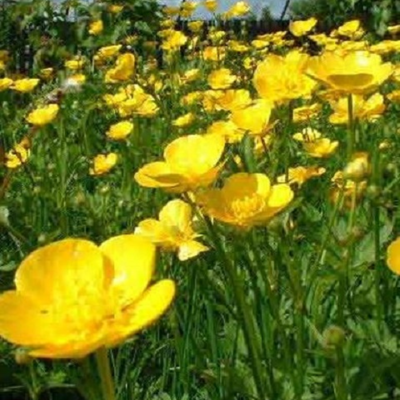

Plants for Pollinators highlights plants selected by the RHS as scientifically proven to tackle the declines in bees, butterflies and other pollinators.
The Meadow Buttercup is the tallest-growing of the buttercups, with a slight preference for damper ground. These bright and buttery, bowl-shaped blooms make an amazing addition to meadows!
- Type: Perennial
- Height: 30–90cm.
- Flowers: May-September
- Soil Requirement: Moist but well-drained
- Light Requirement: Full sun or partial shade
- Natural Habitat: Meadows, grasslands, road verges
- Also known as: Butter Daisy, Goldweed, Meadow Cup

Plants for Pollinators highlights plants selected by the RHS as scientifically proven to tackle the declines in bees, butterflies and other pollinators.
An unusual yet distinct variant of campion, which has grey-tinted foliage and grows drooping, fresh white bladders veined with purple, and five-petalled flowers. A plant with a subtle, withdrawn beauty that also attracts bees and butterflies.
- Type: Perennial
- Height: 20–60cm.
- Flowers: June-August
- Soil Requirement: Well-drained
- Light Requirement: Full sun
- Natural Habitat: Meadows, open forests, hedgerows
- Also known as: Cowbell, Maiden’s Tears

Plants for Pollinators highlights plants selected by the RHS as scientifically proven to tackle the declines in bees, butterflies and other pollinators.
In spite of its name, the Red Campion boasts eye-catching fuschia petals, though planted with White Campion, they may produce precious, pastel-pink hybrids. Regardless, they make a welcome splash of colour in a shady spot, and they’re highly attractive to bees!
- Type: Perennial
- Height: 30-60cm.
- Flowers: April-September
- Soil Requirement: Well-drained
- Light Requirement: Partial Shade
- Natural Habitat: Hedgerows, woodlands
- Also known as: Hare’s Eye, Ragged Jack, Adder’s Flower
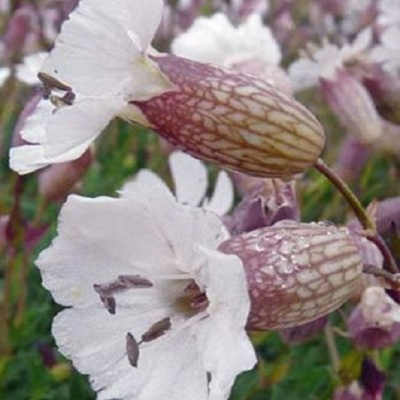

Plants for Pollinators highlights plants selected by the RHS as scientifically proven to tackle the declines in bees, butterflies and other pollinators.
A coastal campion. Grows a bladder-like calyx coloured in coral, ending in bubbly white flowers which look brilliant washing over a rockery like sea foam.
- Type: Perennial
- Height: 15–30cm.
- Flowers: June-August
- Soil Requirement: Well-drained, sandy
- Light Requirement: Full sun or partial shade
- Natural Habitat: Coastal areas, cliffs
- Also known as: Sea Pink, Seaside Catchfly

Plants for Pollinators highlights plants selected by the RHS as scientifically proven to tackle the declines in bees, butterflies and other pollinators.
This pristine white, five petalled perennial is also well known for producing a clovey scent at dusk, not only making it perfect for pollinators, but also making for a lovely plant indoors.
- Type: Perennial
- Height: 30-60cm.
- Flowers: May-October
- Soil Requirement: Well-drained
- Light Requirement: Partial Shade
- Natural Habitat: Roadside verges, hedgerows
- Also known as: Bull Rattle, White Cockle, White Robin

Plants for Pollinators highlights plants selected by the RHS as scientifically proven to tackle the declines in bees, butterflies and other pollinators.
This well-known umbellifer is simple in its beauty, but generous, producing pleasing feathered foliage as well as fountains of foamy white florets, often with a dark red central flower. They're surprisingly eye-catching, making a bold statement in a wild meadow!
- Type: Biennial
- Height: 30-40cm
- Flowers: June-October
- Soil Requirement: Well-drained
- Light Requirement: Full sun
- Natural Habitat: Cliff sides, grasslands, roadsides
- Also known as: Queen Anne’s Lace
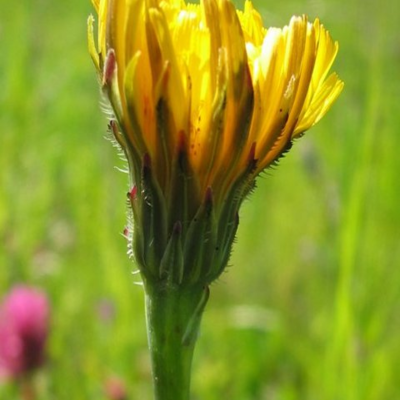

Plants for Pollinators highlights plants selected by the RHS as scientifically proven to tackle the declines in bees, butterflies and other pollinators.
The Common Cat's-Ear is a must-have for meadows, providing a scattering of sunny yellow blooms which return year after year, all while attracting pollinators and being relatively easy to take care of- they simply are the cat's pajamas!
- Type: Perennial
- Height: 30-45cm.
- Flowers: May-September
- Soil Requirement: Well-drained
- Light Requirement: Full sun or part shade
- Natural Habitat: Roadsides, grasslands
- Also known as: Flatweed, False Dandelion
This spindly-white snowflake of a flower have a dainty beauty to them, especially on their pink-tinted, drooping stalks. They’re night-scented flowers, which means that they’re ideal for pollinators.
- Type: Perennial
- Height: 25–60cm.
- Flowers: May-July
- Soil Requirement: Well-drained, dry
- Light Requirement: Full sun
- Natural Habitat: Coastal areas, cliffs, grasslands
- Also known as: Sea Pink, Seaside Catchfly

Plants for Pollinators highlights plants selected by the RHS as scientifically proven to tackle the declines in bees, butterflies and other pollinators.
The Corn Chamomile's daisy-like flowers are well-known for their attractive aroma that's been compared to apples, and make them perfect for pollinators. A flower that's easy to care for, with a lot more charm hiding beneath its simple appearance.
- Type: Annual
- Height: 20-30cm.
- Flowers: May-July
- Soil Requirement: Well-drained
- Light Requirement: Full sun
- Natural Habitat: Grasslands
- Also known as: Mayweed, Field Chamomile
An amazingly aromatic alternative to common grass or daisy lawns, this low-growing, daisy-like flowers make for a pleasing ground cover that is easy to maintain once established, but sensitive to trampling. Plant plugs in full sunlight at least 10cm apart.
- Type: Annual
- Height: 10–20cm.
- Flowers: June-August
- Soil Requirement: Well-drained
- Light Requirement: Full sun
- Natural Habitat: Lawns, grasslands
Imagine a midsummer meadow rife with the Meadow Clary’s tall-growing spikes of striking indigo flowers! Though they’re now a rare sight in the wild, this handsome and hardy clump-growing plant is a sight to behold, on its own or at the back of a border. Noted for its soft foliage, which is aromatic when crushed.
- Type: Perennial
- Height: 80–100cm.
- Flowers: May-August
- Soil Requirement: Well-drained
- Light Requirement: Full sun
- Natural Habitat: Dry grassland, hay meadows, grassy paths
- Also known as: Meadow Sage
Choosing different wildflower plants by species gives you complete control over when you plant them, where you plant them and what the end result will be. And buying wildflower plug plants instead of seeds, means that you don't have to wait for them to germinate - perfect if speed is of the essence!
The full range of over 100 British wildflower plants species from Boston Seeds is available to buy online in trays of 25, 150 and 500 plug plants and all are available with nationwide delivery.
Want to learn more about the likes and dislikes of your favourite wildflower plants? Our handy wildflower species quide will tell you all you need to know - yours to download and keep for FREE.
Buy With Confidence

